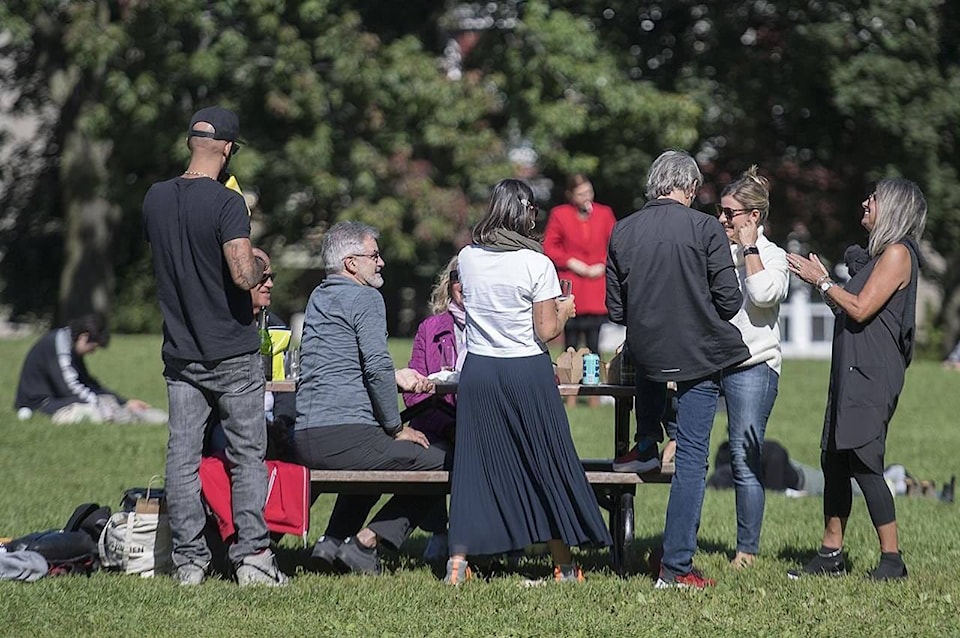As COVID-19 case counts continue to rise across Canada, some of the country’s top doctors are urging people to pop their social bubbles in favour of a more cautious approach.
While experts in psychology and epidemiology agree getting rid of bubbles is the right move in hot-spot regions, they also worry that introducing new restrictions will take some convincing for those who have been socializing more liberally for the last few months.
“I think we had a taste of the good life over the summer,” said Raywat Deonandan, an epidemiologist at the University of Ottawa. “And now there’s going to be a lot of resistance, especially because (we were allowed to socialize) and we avoided the apocalypse, for lack of a better term.”
COVID case counts dwindled nationwide over the the last few months, allowing businesses to reopen and bubbles, usually of about 10 people, to emerge as a safer way to interact with friends and family.
Deonandan says increasing case counts will lead to increasing restrictions. And that’s starting to happen now as cities and provinces report COVID levels not seen since May and June.
Dr. Eileen de Villa, Toronto’s top public health official, said Monday that social bubbles are no longer viable in Canada’s largest city, instead urging people to interact only with those within their households.
British Columbia’s top doctor Bonnie Henry also said Monday that socialization should be limited to peoples’ households or six-person bubbles, while Quebec Health Minister Christian Dube essentially banned visitors to private homes in parts of the province for the next four weeks.
Winnipeg epidemiologist Cynthia Carr says social bubbles can still work in areas of the country where community spread is low. But they’re no longer effective as “harm reduction measures” where cases are rising rapidly.
Getting people to disband their social bubbles can be tricky though, especially for those who had difficulty with isolation in the early stages of the pandemic.
“It’s almost sort of a reset emotionally and mentally isn’t it? You have to go back to that situation,” Carr said. “Part of the challenge … is knowing how it felt. It was lonely and anxiety-inducing.
“But the reality is in some of these cities we’re seeing pretty quick increases (in case counts). We need to … bring that back under control, otherwise this exponential spread could increase pretty quickly.”
Deonandan says some people won’t have a problem limiting their social interactions to early-pandemic levels, but others will.
He expects those who have developed a “perception lag” after being able to socialize so freely in the summer to be especially resistant.
“People think that the threat a) never existed or b) has been averted, and that’s not the case. We simply pushed it aside until now,” Deonandan said. “And as a result of that people are going to be unwilling to accept restrictions to a large extent.”
Steve Joordens, a psychology professor at the University of Toronto, is also concerned with peoples’ perception of what tightening restrictions means.
He says that while public health officials did warn of the second wave in the months before it happened, the messaging could have been more clear to stress that summer socializing would be temporary.
“I wish it had been better marketed in a way (that said) in order to take two steps forward, we’re going to have to take one step back,” he said.
The worry, Joordens says, is that people will feel their efforts to slow the spread of the virus were done in vain.
And if they feel failure, they’re more likely to abandon restrictions altogether the second time around.
“If it starts to feel like we did all the stuff we were told to do and things got a little better but now it’s worse … there’s going to be this sense that it didn’t work,” he said. “We’re back where we were and there’s this helplessness, a disempowerment that can lead to some anxiety and depression, but also probably less of a likelihood that people are going to comply (in the future).”
Dr. Camille Lemieux, the Chief of Family Medicine at the University Health Network, agrees that misleading rhetoric about social bubbles can cause people to defy those regulations.
That doesn’t mean they simply don’t want to follow the rules though. They’re probably just confused by them.
“I don’t think there’s a population running around out there … snubbing their noses at everything that’s going on,” she said. “I think people are concerned, but when they don’t know what to do and everything changes every second day … people throw their hands up in the air and say, ‘Well, might as well do nothing because I don’t understand what to do anymore.’”
That’s the reason Deonandan says the messaging needs to be firm and structured this time around, rather than the “panicked rush to do something” we saw in March and April.
“Now we know what to do,” he said. “So let’s just do it.”
Melissa Couto Zuber, The Canadian Press
Like us on Facebook and follow us on Twitter.
Want to support local journalism? Make a donation here.
